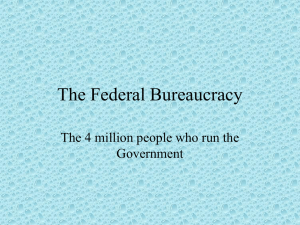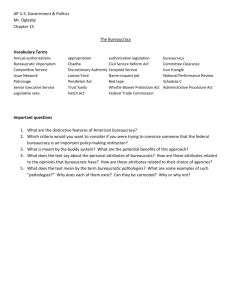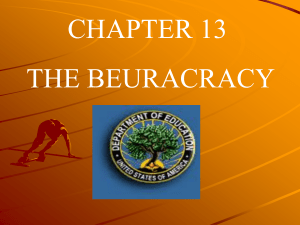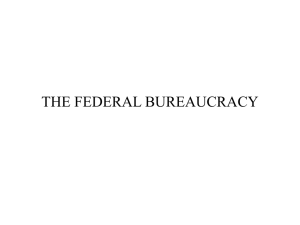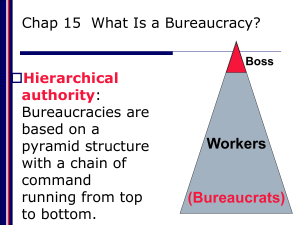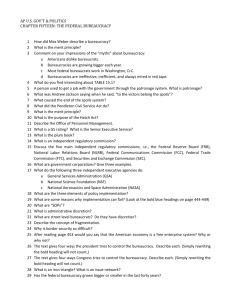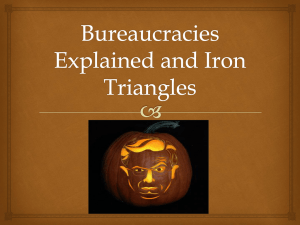The Bureaucracy #4
advertisement
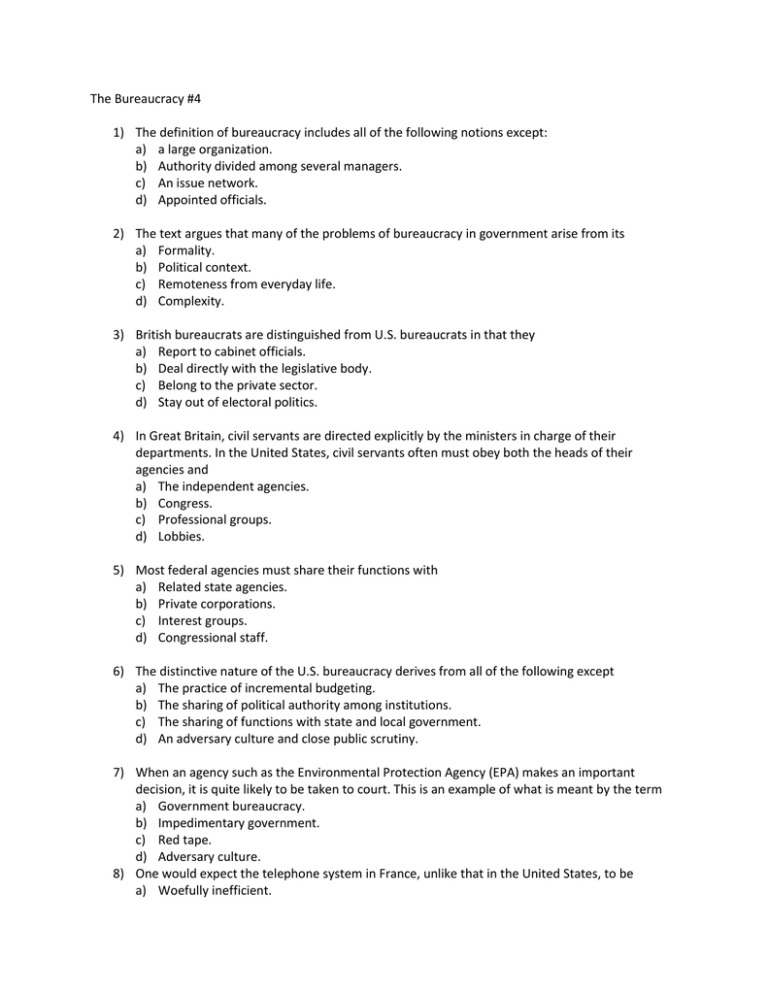
The Bureaucracy #4 1) The definition of bureaucracy includes all of the following notions except: a) a large organization. b) Authority divided among several managers. c) An issue network. d) Appointed officials. 2) The text argues that many of the problems of bureaucracy in government arise from its a) Formality. b) Political context. c) Remoteness from everyday life. d) Complexity. 3) British bureaucrats are distinguished from U.S. bureaucrats in that they a) Report to cabinet officials. b) Deal directly with the legislative body. c) Belong to the private sector. d) Stay out of electoral politics. 4) In Great Britain, civil servants are directed explicitly by the ministers in charge of their departments. In the United States, civil servants often must obey both the heads of their agencies and a) The independent agencies. b) Congress. c) Professional groups. d) Lobbies. 5) Most federal agencies must share their functions with a) Related state agencies. b) Private corporations. c) Interest groups. d) Congressional staff. 6) The distinctive nature of the U.S. bureaucracy derives from all of the following except a) The practice of incremental budgeting. b) The sharing of political authority among institutions. c) The sharing of functions with state and local government. d) An adversary culture and close public scrutiny. 7) When an agency such as the Environmental Protection Agency (EPA) makes an important decision, it is quite likely to be taken to court. This is an example of what is meant by the term a) Government bureaucracy. b) Impedimentary government. c) Red tape. d) Adversary culture. 8) One would expect the telephone system in France, unlike that in the United States, to be a) Woefully inefficient. b) Owned by the government. c) Part of a multinational corporation. d) Privately owned. 9) Whereas European countries tend to control key industries by government ownership, the United States relies primarily on a) Ownership by the states. b) Extremely high taxation. c) Extensive regulation. d) Very little regulation. 10) In the first Congress, it was decided that appointed federal officials would be removable by a) Either the president or the Congress. b) The president and Congress acting together. c) The president alone. d) Congress alone. 11) In the early days of the federal government, the only department that had much power was the a) Treasury Department. b) War Department. c) Post Office Department. d) State Department. 12) James Madison argued that the president alone must be able to fire a federal employee because a) Otherwise he would not be able to control his subordinates. b) He is the person best qualified to judge job performance. c) There would be a considerable danger of corruption if Congress participated in the process. d) This power was clearly implied in the U.S. Constitution. 13) Patronage in the early republic provided the president with all of the following advantages except a) Keeping subordinates supportive of his policies. b) Influencing recalcitrant members of Congress. c) Helping to build up party organization. d) Holding special-interest lobbyists at bay. 14) During most of the nineteenth and twentieth centuries, appointments to the civil service were often controlled by a) Party caucuses. b) Congressional preferences. c) Merit examinations. d) Military considerations. 15) During most of the nineteenth and twentieth centuries, appointments to the civil service were based primarily on a) Merit. b) Education. c) Patronage. d) Wealth. 16) The eightfold increase in the number of federal employees that occurred between 1816 and 1861 was largely the result of a) Abuses of patronage by Congress and the presidency. b) Rapid industrialization and the emergence of a national economy. c) The government’s taking on new functions. d) Increased demands on traditional government functions. 17) The greatest watershed in the expansion of government bureaucracy in the United States occurred during the a) Jacksonian period. b) Civil War. c) Spanish-American War. d) Franklin Roosevelt Administration. 18) Discovery of the administrative weakness of the federal government and calls for civil service reform resulted from a) The Civil War. b) The Louisiana Purchase. c) World War I. d) World War II. 19) Generally, the role of government bureaucracies up to the end of the nineteenth century was to a) Provide benefits for interest groups. b) Solve social and economic problems. c) Regulate unions. d) Protect state and local government. 20) The shift in the role of the federal bureaucracy that occurred between 1861 and 1901 was from a) Economic regulation to tax regulation. b) Regulation to service. c) Commerce to regulation. d) Federal services to state services. 21) A constitutional limitation on the federal bureaucracy’s ability to regulate the economy is that a) Only the president has the constitutional authority to regulate commerce. b) Only Congress has the constitutional authority to regulate commerce. c) Only the Supreme Court has the constitutional authority to regulate commerce. d) Commerce cannot be regulated by the federal government. 22) The notion of laissez-faire and of the congressional mandate to regulate led to the bureaucracy’s performing a a) Service role. b) Regulatory role. c) Redistributive role. d) Role of litigation. 23) Restrictions on the powers of federal administrators tended to be set aside during times of a) Economic emergency. b) War. c) Prosperity. d) National expansion. 24) Periodically, the size of the bureaucracy has grown substantially. These times of growth have generally occurred during a) Depressions. b) Wars. c) Periods of prosperity. d) Recessions. 25) A dramatic increase in activism by the federal bureaucracy occurred in the twentieth century, largely as a consequence of a) The growth of patronage and the rise of political parties. b) The Sixteenth Amendment and the Social Security Act. c) A desire for limited government and an end to earlier regulatory practices. d) The Great Depression of the 1930s and World War II. 26) A dramatic increase in activism by the federal bureaucracy occurred in the twentieth century, largely as a consequence of a) The growth of patronage and the rise of political parties. b) The Sixteenth Amendment and the Social Security Act. c) A desire for limited government and an end to earlier regulatory practices. d) Changes in public attitudes and new constitutional interpretations. 27) Largely because of two major events of the twentieth century – the Great Depression and World War II – the features of the federal bureaucracy changed. What characterized this change? a) People began to call for more limited, less intrusive government. b) Administrative agencies could no longer be instructed by Congress to act in the public interest. c) People came to expect government to solve social and economic problems. d) The Supreme Court ruled that Congress could no longer delegate powers to administrative agencies. 28) Today’s bureaucracy is largely a product of which two events? a) The Korean War and the Vietnam War b) The Great Depression of the 1930s and the Vietnam War c) World War I and World War II d) The Great Depression of the 1930s and World War II 29) An important effect of World War II on the federal government was to a) Bring an end to laissez-faire government. b) Greatly increase government revenues from taxation. c) Strip various regulatory agencies of their policy-making functions. d) Introduce the concept of pay-as-you-go government. 30) From 1913 to 1940, the average American paid approximately ____ in income taxes each year. a) $7 b) $850 c) $3,000 d) $14,000 31) If you wanted to do away with high federal taxation, you might see a quick solution in the repeal of the a) Sixteenth Amendment. b) Nineteenth Amendment. c) Twenty-first Amendment. d) Twenty-sixth Amendment. 32) The number of civilians working for the federal bureaucracy has not increased much since 1970. This observation fails to account for, however, the a) Enormous decrease in the government work force that occurred between 1986 and 1990. b) Enormous increase in the government work force that occurred between 1965 and 1970. c) Enormous increase in state and local bureaucracies that occurred during this period. d) Growing number of people who work indirectly for the government. 33) Most employees of the federal government are a) On federal contracts. b) Federal civil servants. c) Postal workers. d) Uniformed military. 34) An example of someone who works indirectly for the federal government would be an employee of a a) Private company that is federally funded. b) Congressional select committee. c) Local government agency that is locally funded. d) State government agency that is state funded. 35) The importance of the federal bureaucracy today can be measured in part by the total number of federal employees or, more accurately, by the a) High proportion of full-time employees on the government payroll. b) Discretionary authority of its appointed officials. c) Number of agencies that now form the federal bureaucracy. d) Number of employees who write the regulations and spend the money. 36) A public official who decides to follow a course of action that is not specified by law but could be inferred from it is most likely to be a) Overstepping his or her authority. b) Violating the law. c) Playing politics. d) Exercising discretionary authority. 37) The text argues that the power of a bureaucracy is best measured by its a) Discretionary authority. b) Size. c) Budgets. d) Organized opposition. 38) When we speak of the discretionary authority of appointed officials, it means their authority to a) Shift federal monies from agency to agency, depending on need. b) Act without specific executive direction. c) Make policies that are not spelled out in advance by laws. d) Spend federal monies, even though they are not officially part of the federal bureaucracy. 39) Which of the following is not an area in which the power of the bureaucracy has grown dramatically in recent years? a) Paying subsidies to particular groups b) Transferring money to state and local governments c) Creating regulations for various sectors of society d) Building nuclear energy sources 40) The broad factors that best explain the behavior of bureaucratic officials include all of the following except a) How they are recruited and rewarded. b) Their personal attributes. c) The influence of outside forces on them. d) Their party preferences. 41) A person appointed to a government position after passing an examination is probably joining the a) Excepted service. b) Competitive service. c) Patronage system. d) Department of State. 42) Those federal bureaucrats not appointed on the basis of qualifications designed by the Office of Personnel Management (OPM) are called a) Civil-service employees. b) Life-tenure employees. c) The excepted service. d) The competitive service. 43) A post office worker or Federal Bureau of Investigation (FBI) agent would typically be part of the federal bureaucracy known as a) The competitive service. b) Schedule C positions. c) The merit service. d) The excepted service. 44) Which of the following statements about the excepted service is true? a) Only the president can make appointments to this service. b) Most employees are appointed by other agencies on the basis of merit within that agency. c) Most appointments are made on the basis of patronage. d) Most appointments are made on the basis of qualifications designed or approved by the Office of Personnel Management (OPM). 45) If you worked in a senior position on a successful presidential campaign and the new president then wished to have your advice while in office, you would be most likely appointed to a) The competitive service. b) Congress. c) A Schedule C position. d) A federal union. 46) All of the following are non-merit appointments to the excepted service except a) Presidential appointments. b) Schedule C jobs. c) Office of Personnel Management (OPM) assignments. d) Non-career executive assignments (e.g., National Endowment for the Arts jobs). 47) The merit system began with the a) Sixteenth Amendment. b) Pendleton Act of 1883. c) Civil rights cases of 1873. d) New Deal of the 1930s. 48) Employees who are blanketed in are ones who a) Are prohibited from engaging in partisan politics. b) Competed for jobs through the Office of Personnel Management (OPM) merit system. c) Are ensured patronage jobs, as long as their party wins the presidential election. d) Are covered by the merit system, although they are appointed. 49) One advantage of the merit system to presidents is that it a) Protects them from patronage demands. b) Grants them the power of appointment. c) Insulates them from control by the Office of Personnel Management (OPM). d) Excludes employees in the excepted service. 50) One advantage of the merit system to presidents is that it a) Protects their patronage appointees from new presidents. b) Grants them the power of appointment. c) Insulates them from control by the Office of Personnel Management (OPM). d) Excludes employees in the excepted service. 51) When a civil-service job is filled on a name-request basis, this is an example of the a) Spoils system. b) Interservice system. c) Pendleton Act of 1883. d) Buddy system. 52) Using the buddy system, an agency can circumvent the usual Office of Personnel Management (OPM) search process by a) b) c) d) Blanketing in a job candidate. Issuing a merit dispensation. Asking the president to appoint a specific candidate. Tailoring a job description to a specific candidate. 53) If an agency committed to consumer protection hires someone from a private environmental protection group, the type of recruitment illustrated would be a) Recruitment from an issue network. b) Recruitment by patronage. c) A non-career assignment. d) Recruitment by favoritism. 54) Someone who is hired by an agency from within an issue network is most likely to hold policy views that are a) Academic and nonpartisan. b) Representative of the general public. c) Congenial to that of the agency. d) Immune from the influences of the buddy system. 55) The agency responsible for ensuring fair treatment of civil servants is the a) Merit System Protection Board. b) Office of Personnel Management. c) Civil Service Commission. d) Senior Executive Service. 56) Which of the following statements about the firing of federal employees is true? a) Only bureaucrats who were blanketed in can be fired. b) Only employees in the competitive service can be fired. c) Only employees in the excepted service can be fired. d) Most bureaucrats cannot be fired. 57) Not a good question 58) Members of the Senior Executive Service, compared to other bureaucrats, are a) Harder to transfer but less well paid. b) Easier to transfer but better paid. c) Harder to transfer and better paid. d) Easier to transfer and less well paid. 59) Which of the following was created in 1978 in an attempt to give the president more flexibility in dealing with high-level bureaucrats? a) Civil Service Reform Commission b) Merit System Protection Board c) Senior Executive Service (SES) d) Office of Personnel Management (OPM) 60) The fact that agencies usually recruit their own staff, often on a name-request basis, should lead us to expect that these recruits will possess the a) b) c) d) Intelligence of a turnip. Agency point of view. Political will to initiate new struggles. Necessary expertise to advise political officials. 61) Civil service recruitment and retention policies work to ensure that most agencies have a(n) a) Agency point of view. b) Presidential point of view. c) Congressional point of view. d) National-interest point of view. 62) When a person is selected by the president to head an agency and to shift its policies in the direction of the president’s, the appointee generally finds that a) Agency personnel change direction quickly. b) Career subordinates have very little influence on policy. c) An agency is immune to presidential politics. d) Subordinates wield considerable power. 63) A survey of top-level, nonpolitical federal bureaucrats found their political outlooks to be a) Mostly conservative or liberal. b) Less pro-government than the public at large. c) Similar to the public at large. d) Very different than the public at large. 64) Relative to their share of the population, Republicans tend to be overrepresented in the a) Environmental Protection Agency (EPA). b) Food and Drug Administration (FDA). c) Conservative Counseling Corps. d) Department of Defense. 65) If bureaucrats regularly sabotage the actions of political bosses with whom they disagree, one would expect Republicans to be hurt more than Democrats. Why? a) Because Republican programs are more vulnerable to sabotage b) Because bureaucrats tend to be liberal c) Because more government money is spent on Republican programs d) Because the federal bureaucracy, at the moment, is overwhelmingly conservative 66) Which law established the Office of Special Counsel? a) The Taft-Hartley Act b) The Civil Service Act c) The Administrative Procedure Act d) The Whistle Blower Protection Act 67) The Whistleblower Protection Act of 1989 is designed to protect a) Agencies that are being undermined by their employees. b) Agencies that are being undermined by Congress. c) Agency heads who fire employees for misconduct. d) Bureaucrats who tell on their bosses. 68) Bureaucrats’ own values and beliefs are likely to have the greatest influence on their work when their duties are a) Loosely defined. b) Routinized. c) Greatly affected by laws. d) Closely monitored. 69) Bureaucrats’ own values and beliefs are most likely to have the least influence on their work when their duties are a) Loosely defined. b) Highly structured. c) Greatly affected by laws. d) Professional in nature. 70) If a civil servant is in a complex, loosely defined position, one can expect his or her political and social attitudes to a) Play a minor role in his or her decisions. b) Balance those of his or her colleagues. c) Be frustrated by the position. d) Strongly influence his or her decisions. 71) Lawyers working for the Federal Trade Commission (FTC) are most likely to select cases that a) Are costly to the consumer. b) Are likely to develop new legal precedents. c) Clearly involve criminal malfeasance. d) Are acceptable to the administration. 72) A personal attribute that has been shown to have a clear effect on bureaucratic behavior is a) Socioeconomic background. b) Gender. c) Regional background. d) Professional training. 73) Before recommending legal action against a business for illegal practices, an economist with the Federal Trade Commission (FTC) might first want to know whether a) The business firm attended a secret meeting with competitors. b) The illegality will be easy to prove in court. c) Consumers have borne a heavy cost as a consequence of the practice. d) Congress sympathizes with the business firm. 74) Having a strong agency culture can help an agency by motivating its employees to work hard, but it can also hurt it by a) Increasing the number of highly structured roles. b) Making an agency resistant to change. c) Reducing cooperation among employees. d) Encouraging whistleblowing. 75) Redundant question 76) The biggest difference between a government agency and a private organization is the a) Presence of a strong, binding agency culture. b) Influence of merit on hiring and promotion. c) Greater number of constraints on the agency. d) Relative absence of red tape in the agency. 77) One of the major constraints under which government agencies operate is the a) Large number of regulations they must adhere to. b) Power of issue networks to determine agency policy. c) Absence of competing forces in the public sector. d) Presence of a great many highly structured roles. 78) The Freedom of Information Act and the Administrative Procedure Act are examples of a) Government-wide constraints on bureaucracy. b) Early, unconstitutional attempts to restrain bureaucrats. c) Laws that apply only to Congress. d) Regulations that limit executive powers principally. 79) A particularly important constraint on bureaucratic power is the need to a) Carry out the policies of the president. b) Check congressional power. c) Obtain agreement from other parts of the bureaucracy. d) Obtain the approval of Congress. 80) Among the effects of the many constraints on government agencies is the fact that a) Many important issues tend to receive scant attention. b) Taking action is easier than blocking action. c) Too much authority is delegated to lower-ranking employees. d) Government often acts slowly. 81) Among the effects of the many constraints on government agencies is the fact that a) Many important issues tend to receive scant attention. b) Blocking action is easier than taking action. c) Too much authority is delegated to lower-ranking employees. d) Decisions are often made too quickly. 82) Among the effects of the many constraints on government agencies is the fact that a) Many important issues tend to receive scant attention. b) Taking action is easier than blocking action. c) Too much authority is delegated to lower-ranking employees. d) Government sometimes acts inconsistently. 83) Among the effects of the many constraints on government agencies is the fact that a) Many important issues tend to receive scant attention. b) Taking action is easier than blocking action. c) Lower-ranking employees are reluctant to make decisions on their own. d) Government sometimes acts too quickly. 84) Among the effects of the many constraints on government agencies is the fact that a) Many important issues tend to receive scant attention. b) Taking action is easier than blocking action. c) Too much authority is delegated to lower-ranking employees. d) Citizens complain of red tape. 85) In a bureaucracy, why does government sometimes act inconsistently? a) Because constraints ensure that relatively few voices will be heard before a decision is made b) Because what is done to meet one constraint may endanger another constraint c) Because the more constraints that must be satisfied, the longer getting things done will take d) Because the best way for employees to stay out of trouble is to let their boss make the decision 86) In a bureaucracy, why is blocking action easier than taking action? a) Because the more constraints that must be served, the more forms that must be filled out b) Because constraints ensure that many voices must be heard before a decision is made c) Because the more constraints that must be satisfied, the longer getting things done will take d) Because the best way for employees to stay out of trouble is to let their boss made the decision 87) Probably the most effective means an agency has of remaining powerful is a) Cultivating public opinion. b) Attaining a monopoly on technical expertise in a particular policy area. c) Entering alliances with influential interest groups. d) Doing its job well. 88) The usual definition of an iron triangle includes all of the following except a) An agency. b) A congressional committee. c) An issue network. d) An interest group. 89) The relationship among an agency, a committee, and an interest group was described in the past as a) Red tape. b) An issue network. c) An iron triangle. d) Laissez-faire. 90) Because many federal agencies were created to serve some sector of society, we should not be surprised to learn that the American Legion is closely aligned with the a) Department of Veterans’ Affairs. b) Department of Education. c) Department of Commerce. d) Department of the Interior. 91) Not a good question 92) Which of the following statements about agency allies is correct? a) The Small Business Administration (SBA) is part of an iron triangle. b) Iron triangles are far more common today than in the past. c) Presidential hiring from within issue networks is prohibited by law. d) Congress often establishes issue networks to study key policy issues. 93) Why are iron triangles less common today than they once were? a) Because agencies today are pressured by so many interest groups b) Because iron triangles are no longer allowed by many agencies c) Because congressional leadership is so much stronger today d) Because the courts have stepped in to limit the intervention of interest groups in agency affairs 94) Why are iron triangles less common today than they once were? a) Because most agencies are now subject to control by many congressional subcommittees b) Because iron triangles are no longer allowed by many agencies c) Because agencies today are subject to pressure from fewer interest groups d) Because the courts have stepped in to limit the intervention of interest groups in agency affairs 95) Secretaries of agriculture have found that they have considerable discretion in setting policy despite the involvement of strong interest groups because a) One interest group dominates all the others. b) Of the inherent power of the Department of Agriculture. c) Of presidential support for major policies. d) The groups most often work against rather than with one another. 96) Which of the following statements about issue networks is correct? a) They tend to be highly academic and nonpartisan. b) They tend to hold views that are in opposition to the party in power. c) They are groups that regularly debate government policy on specific issues. d) They are composed mostly of federal bureaucrats of the same party as the current president. 97) One way the Congress exercises authority over agencies is through the a) Statutes that create and define them. b) Control of Office of Personnel Management (OPM) hiring practices. c) Use of discharge petitions. d) Dismissal of an agency head. 98) One way that Congress exercises authority over agencies is through the a) Authorization of agency spending. b) Control of Office of Personnel Management (OPM) hiring practices. c) Use of discharge petitions. d) Dismissal of an agency head. 99) Congress exercises authority over agencies through all of the following except a) Statutes that create and define them. b) Authorization of agency spending. c) Appropriations for agency spending. d) Appointments of agency heads. 100) a) b) c) d) Which of the following oversight functions can Congress not perform? Authorization of an agency budget Appropriation of an agency budget Creation of an agency Dismissal of an agency head 101) a) b) c) d) One way that Congress exercises authority over agencies is through the Appropriation of funds for agency spending. Control of Office of Personnel Management (OPM) hiring practices. Use of the discharge petition. Dismissal of an agency head. 102) a) b) c) d) Which of the following characterizes appropriations? They consist of money dispersed through informal channels They originate in the legislative committees They are usually made annually They consist of money that is not set aside for specific use 103) a) b) c) d) Compared to appropriations, authorizations are Usually smaller. Usually larger. Subject to review less often. Less complicated to administer. 104) a) b) c) d) The main reason some interest groups are important to agencies is that these groups Are important to Congress. Can supplement agency funds. Are grassroots organizations. Have a long tradition behind them. 105) When a law originating in a legislative committee specifies a certain sum of money, it is called a(n) a) Allocation measure. b) Appropriation measure. c) Authorization measure. d) Fiscal measure. 106) a) b) c) d) The most powerful group in Congress in terms of control over an agency’s budget is the House Ways and Means Committee. House Committee on Committees. House Steering Committee. House Appropriations Committee. 107) a) b) c) d) The process of revising agency budget requests is commonly called Gutting. Reconciling. Bait and switch. Marking up. 108) All of the following have weakened the power of appropriations committees over government agencies except a) The establishment of trust funds that operate outside the regular government budget. b) The change in authorization of many programs from permanent or multiyear to annual authorizations. c) The need for these committees to focus on huge budget deficits and target spending limits. d) The 1983 Supreme Court decision ruling unconstitutional the legislative veto. 109) Redundant question 110) Redundant question 111) Redundant question 112) When congressional committees require that agency decisions be submitted to them before the agency implements them, the committees are exercising the power of a) Authorization. b) Committee clearance. c) Appropriation. d) Committee support. 113) a) b) c) d) An example of an informal congressional control over agencies is when Congress refuses to appropriate funds for agency spending. Individual members of Congress seek privileges for constituents. Congress refuses to authorize funds for agency spending. The House Appropriations Committee chairperson uses a legislative veto. 114) a) b) c) d) The effect of a legislative veto is to Give Congress control over certain executive decisions. Strip House chair-people of powers of appropriation. Give Congress control over the appointment of agency heads. Strip House chair-people of powers of authorization. 115) a) b) c) d) 116) a) The legislative veto is a stratagem to increase the power of Congress. The White House. The states. The courts. The legislative veto was declared unconstitutional in Immigration and Naturalization Service v. Chadha. b) United States v. Nixon. c) Brown v. Board of Education. d) Marbury v. Madison. 117) In practice, the effect of the Supreme Court ruling against the legislative veto in the Chadha case has been a) To end the use of the legislative veto. b) To force Congress to mark up a greater number of bills. c) To revise the wording of the legislative vetoes they use. d) Negligible. 118) a) b) c) d) Congressional supervision of the bureaucracy involves all of the following except Congressional statutes. Budgetary appropriations. Committee investigations. Bills of attainder. 119) The text concludes that when bureaucracies operate at cross-purposes, it is usually because a) Congress wants it that way. b) The White House wants it that way. c) The bureaucracy has grown too complex. d) The bureaucracy has not yet matured. 120) When a citizen is required by an agency to use one accounting system rather than another, or to file forms before receiving any benefits, such requirements are called a) Duplication of functions. b) Red tape. c) Mandatory incursions. d) Arbitrary statutes. 121) Among the “pathologies” commonly attributed to bureaucracies are all of the following except a) Conflict. b) Synergism. c) Duplication. d) Imperialism. 122) Redundant question 123) One bureaucratic “pathology” described by the text is imperialism, meaning the tendency of agencies to a) Work at cross-purposes with one another. b) Spend more than is necessary to buy some product or service. c) Grow, irrespective of the benefits and costs of their programs. d) Generate complex and sometimes conflicting rules. 124) One bureaucratic “pathology” described by the text is conflict, meaning the tendency of agencies to a) Grow, irrespective of the benefits and costs of their programs. b) Work at cross-purposes with one another. c) Spend more than is necessary to buy some product or service. d) Generate complex and sometimes overlapping rules. 125) a) b) c) d) Governmental hiring practices exemplify the need for all of the following except Proceeding on the basis of merit. Satisfying strict accounting rules. Allowing for citizen access. Encouraging partisan politics. 126) a) b) c) d) The source of bureaucratic “pathologies” is usually The agency itself. The president. Congress. Interest groups. 127) Buses in major cities are required to have lifts for people using wheelchairs because of a decision made by a) The White House. b) Congress. c) The Department of Transportation. d) The Department of Health and Human Services. 128) Not a good question 129) Buying American, using minority contractors, and paying the prevailing wage are all examples of a) Red tape that drives up costs. b) Practices by public and private agencies. c) Bureaucracy released from political control. d) Noncontroversial bureaucratic routines. 130) a) b) c) d) To reduce waste in government, one is also likely to have to increase Synergism. Duplication. Red tape. Imperialism. 131) Which of the following statements about the attitude of most Americans toward government bureaucrats and bureaucracies is true? a) They are satisfied with bureaucrats if they have actually had contact with public officials. b) They find individual bureaucrats rigid, hostile, and unhelpful. c) They believe that bureaucracy on the whole should be supported. d) They have had mostly negative experiences with bureaucrats. 132) Which of the following statements is not true of Americans’ attitudes toward bureaucracy? a) Most Americans view bureaucracy unfavorably. b) Actions of the bureaucracy are frequently challenged. c) Americans feel ill-treated by the bureaucrats with whom they deal. d) Americans want many, often conflicting, things from the bureaucracy. 133) a) b) c) d) 134) According to the text, most of the problems of bureaucracies are Not very serious when examined closely. Decreasing with the passage of time. Actually quite desirable. Inseparable from the problems of government. Not a good question 135) A plan to reform the bureaucracy popularly called the plan to “reinvent government” is the a) Joint Committee on Reorganization. b) First Hoover Commission. c) Grace Commission. d) National Performance Review. ANSWERS 1) 2) 3) 4) 5) 6) 7) 8) 9) 10) 11) 12) 13) 14) 15) 16) 17) 18) 19) 20) 21) 22) 23) 24) 25) 26) 27) 28) 29) 30) 31) 32) 33) 34) 35) 36) 37) 38) 39) 40) C B A B A A D B C C A A D B C D B A A B B A B B D D C D B A A D A A B D A C D D 41) 42) 43) 44) 45) 46) 47) 48) 49) 50) 51) 52) 53) 54) 55) 56) 57) 58) 59) 60) 61) 62) 63) 64) 65) 66) 67) 68) 69) 70) 71) 72) 73) 74) 75) 76) 77) 78) 79) 80) 81) 82) B C D B C C B D A A D D A C A D N/A B C B A D D D B D D A B D B D C B N/A C A A C D B D 83) C 84) D 85) B 86) B 87) C 88) C 89) C 90) A 91) N/A 92) A 93) A 94) A 95) D 96) C 97) A 98) A 99) D 100) 101) 102) 103) 104) 105) 106) 107) 108) 109) 110) 111) 112) 113) 114) 115) 116) 117) 118) 119) 120) 121) 122) 123) 124) D A C B A C D D D N/A N/A N/A B B A A A D D A B B N/A C B 125) 126) 127) 128) 129) 130) 131) 132) 133) 134) 135) D C C N/A A C A C D N/A D
